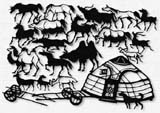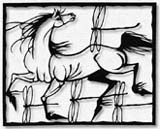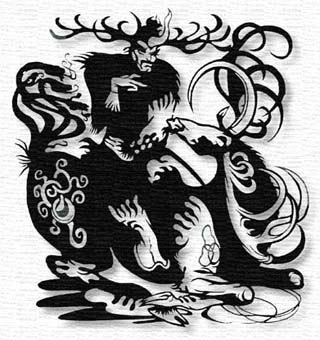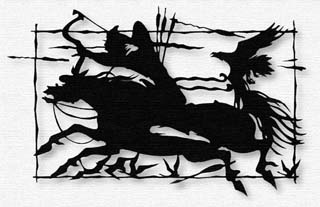April-May 2002
Mongolian
Magic
Turburam Sandagdorj, papercuts
Ten years ago Foundation 3,14 invited a group of Mongolian artists to exhibit in Norway. Among them were young Turburam with his magic scissors. Mongolia's past and present is magically captured in Turburam's images. As an artist he approaches his own history and legacy and portrays it in astonishing detail in his papercuts.

Paper, the main material of papercuts, is one of the four great inventions of ancient China. Around the first century A.D., the Chinese invented paper. The inventor was Cai Lun who lived more than 3,000 years ago. As early as in the Western Han Dynasty (206 B.C. - A.D. 25), China began mass production of paper.


Prior to the invention
of paper people used thin sheets of other materials to make ornamental
engraving.
Examples can be found
in many historical records. An engraved leather sheet unearthed in 1966
from Tomb No. 1 in Wang-shan in Jiangling, Hubei Province, is believed
to be left from the Warring States Period (476-221 B.C.).

Carved on the leather sheet are successive geometric figures and patterns formed by many dense circles and triangles. These engraved objects are not papercuts, but their engraving technique and art style can be said to be the predecessor of the art of papercutting.
Papercut as an art form originated in China. The first papercut can be traced date back to the period known as the Northern and Southern Dynasties (A.D. 386-581).
In the T'ang Dynasty
(A.D. 618-906) papercuts are the subject of a poem by the poet Ts'ui Tao-yung
and from other sources of this period they are described as being used
to decorate plants and worn by ladies in their hair in form of butterflies
and flowers.
The earliest patterns cut out of paper so far found in China are the ones of the Northern Dynasties Period (A.D. 386-581), examples of which are five circular papercuts unearthed from a place near Flaming Mountain in Turpan, Xinjiang. Among these are two papercuts of pairs of monkeys and pairs of horses
In modern Western
culture the closest comparison would be the tattooists. His patterns and
images could easily be imagined worn by the younger generations and his
warriors come alive on rippling muscles under the thin
surface of skin.
Sandagdorj Turburam
could very well be compared to many of the eminent
tattooists around the world.
His ethnically inspired
images in black may follow in the tradition of tattoos seen among the
Iban tribes on Borneo or for that matter as seen among North African Arabs.
His papercuts also
carry references to 18th and 19th century European
traditions. In 18th and 19th century Europe papercuts were used for
portraits or caricature.
Turburam's focus is more on history, lifestyle and ethnography. The odd
portrait can, however, be seen among his works.
Turburam's use of
the scissors is a fascinating study of an artist's ability
to capture and re-create life as he sees it.
Artist
Biodata
Turburam was born in family of artist in Ulaanbaatar, Mongolia in 1969.
He graduated in ceramics
from the state college of Fine and Decorative Arts in1988 and from the
National University of Design in 1990.
* In 1988-1990, he
had 3 exhibitions in Ulaanbaatar, followed by
* Bergen,Norway 1991
* Suwalki,Poland 1993
* Matsue,Japan 1994
* Osaka,Japan 1995
* Karlsruhe, Germany1996
* Osaka,Japan 1996
* Nishinomiya,Japan 1996
* Osaka,Japan 1997
* Amagi,Japan 1997
* Nagasaki,Japan 1997
* Osaka,Japan 1998
* Tokyo,Japan 2001
* Tokyo,Japan 2002,Feb
In 1990 he won the 1st prize in the book illustration competition for the 750th Anniversary of "The Secret History of The Mongols"
In 1992, he became a Laureate of the Mongolian Artists Union.
In 1999, he became an Academic of the Chinggis Khaan Academy
For more images, please click here.